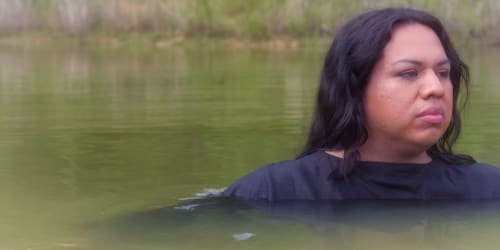For nearly two decades, Jeffrey Gibson has sought to complicate ideas of identity and heritage through multiform work rooted in modernist abstraction, indigenous traditions, and queerness. His art is currently on display in a retrospective at the Mississippi Museum of Artin Jackson; a survey at the Wellin Museum of Art at Hamilton College in Clinton, New York; the inaugural exhibition at the Maria & Alberto de la Cruz Art Gallery at Georgetown University in Washington, DC; and a solo show of new paintings at Sikkema Jenkins & Co. in New York City, which is on view through November 27, 2018.
PEOPLE OFTEN DESCRIBE MY WORK WITH WORDS LIKE VULNERABILITY. For me, it’s not always about vulnerability, but about not being afraid to share something really personal. Individuals are made of specifics. I hate the word universal, but at the same time I hope that, by being honest, there’s some crossover with other people’s experiences. My work relies a lot on the assumption that we’re all living in the same world; yet, when I make new work, I’m trying to be as earnest about my own experience as possible. Sometimes honesty itself is really provocative.
On view at the Wellin Museum is my first video project, I Was Here. It documents and reimagines a day in the life of Macy, a trans woman living on a Choctaw reservation in Mississippi. When I began the video two years ago, I wasn’t thinking about trans rights. It was more “This person represents my fears of who I am in Mississippi,” where my family is from. The work is a hybrid of documentary and invented narrative, and is based on both my reverence for and fear of the Mississippi land. When I was younger, I didn’t have an attachment to the land; I wasn’t raised that way. Now I approach the land academically first—considering Native relations with the US government, contemplating the country as a place. It’s more intellectualized. Then it becomes emotional, and I realize the horrific history that has taken place here. When I meet members of the LGBT community living on reservations, I see what it could be like. I don’t think I could do it. I’m impressed by their strength and resilience. Both of my grandfathers established Indian churches within the community—Southern Baptist churches—and my relationship to religion was something I wanted to explore. And so, for the video, I had Macy share her daily routines and then walk through the woods and ultimately baptize herself in a lake.
Cultural responsibility used to feel limiting to me, but I now think that had to do with popular, and narrow, definitions of tradition and history. As I’ve gotten older, I’ve embraced responsibility. Not everybody has something in their past that draws their attention to what it’s like to be a queer person in central Mississippi. There’s something valuable about the responsibility to speak in whatever way you can. The Wellin Museum offered me an opportunity where I didn’t have to forefront my Native American identity. The exhibition instead arose from my references to the world of fashion, how people adorn themselves to signify who they are. People often refer to the “camp” and “kitsch” elements of my work sheepishly, unsure of how I’m going to react. But as aesthetics I think camp and kitsch can be very subversive. Working with garments opened up possibilities to simultaneously incorporate text, patterns, images, bodies, and movement.
The show at Sikkema Jenkins also let me focus on aspects of my work that I’ve felt were behind the Native American aesthetics, materials, and content. When it came time to make these paintings, I realized I wanted to make incredibly rich, saturated, patterned works where text was central as subject matter. The first painting was I Am a Rainbow Too. Being able to foreground queerness in the Wellin—queerness in a broad way, not just in terms of sexuality—made the paintings at Sikkema Jenkins possible.
I truly respect tradition. At the same time, my husband, my daughter, and I form a very mixed family in every way. Our backgrounds are Dominican, Puerto Rican, Norwegian, Cherokee, Choctaw. We have to generate traditions that support us because so many others won’t. In my family, we’re fans of believing that time moves on, that change happens. Having to rethink how you exist in this world is, for me, the nature of tradition.
— As told to Zack Hatfield

